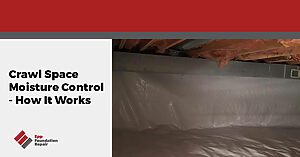Tired of dealing with an unsightly, uneven basement floor? The good news is there are a few tried-and-true techniques available that will help ensure lasting results when leveling out your basement floor. In this blog post, we’ll review what causes uneven basement floors, how to level an uneven basement floor the right way, the wrong way to level an uneven floor and some things you can do to help prevent an uneven basement floor.
What Causes Uneven Basement Floors?
An uneven basement floor usually means the soil under the floor is weak and unable to support the floor. The following are the most common causes of uneven basement floors:
- Problematic soil beneath the slab – Soil that contains a lot of clay swells as it absorbs moisture and then shrinks as it dries out. This can cause the basement floor to lift slightly as the soil expands and then settle back down as the soil dries out and shrinks. This back-and-forth movement – which is usually seasonal – can eventually lead to an uneven basement floor.
- Soil that wasn’t adequately prepared – Before pouring basement floors, it’s crucial to compact the soil to reduce the space between soil particles. If this vital step is overlooked or performed incorrectly, there’s a chance the basement floor will settle unevenly into the ground after it’s poured.
- Poor drainage – If poor drainage causes groundwater to accumulate under and around the basement floor, it can lead to problems like soil erosion, which can cause voids to form under the floor. If the basement floor settles into the voids, it can become uneven.
How To Level a Basement Floor
The chosen repair solution for leveling a basement floor will depend on what caused the floor to become uneven. The two most common methods for leveling an uneven basement floor are polyjacking and underpinning.

Polyjacking
Polyjacking involves drilling small holes in the basement floor and injecting expanding polyurethane foam under the slab to fill voids. The foam rapidly expands, and this lifts and levels the basement floor.
Underpinning
If the basement floor became uneven because of differential settlement, underpinning using push or helical piers would be used. Underpinning extends the foundation down to load-bearing soil. Once the piers are in place, the foundation is gently lifted and leveled.
The Wrong Way to Level an Uneven Basement Floor
There are three things you don’t want to do to level an uneven basement floor: Use self-leveling compounds, pour new concrete on top of the floor to make it even, and mudjacking. These are, at best, temporary fixes that don’t address the root problem. Here’s why they aren’t a long-term solution:
- Self-leveling compounds – If the basement floor is uneven because the soil under it is weak, adding something heavy on top of the floor, like a self-leveling compound, will probably worsen the problem. Sure, the floor might be level for a short period. However, it will eventually start to sink again because you haven’t solved the root problem, and you’ve added more weight to the floor.
- Digging up the floor and pouring a new one – This is another temporary solution because you haven’t solved the problem of why the previous floor became uneven. Digging up and replacing a basement floor is also costly and time-consuming.
- Mudjacking – Mudjacking is the old-school way to lift and level an uneven concrete slab. Today, polyjacking is the preferred method because the foam used in polyjacking is very lightweight. The cement-based slurry used in mudjacking is heavy and can sometimes cause a concrete slab to become even more uneven.
How to Prevent a Basement Floor From Becoming Uneven
Because excess moisture in the ground is the leading cause of problems such as uneven basement floors, the best way to prevent issues is to ensure the soil around the foundation remains dry. Here are some ways to do that:
- Regrade the yard around the foundation, if necessary – Regrading the yard is an inexpensive yet effective method to ensure groundwater drains away from the foundation. This helps to prevent water accumulation at the base of the foundation, which can cause problems, eventually leading to an uneven basement floor.
- Use downspout extensions – These carry runoff away from the foundation before release, reducing the likelihood of water soaking into the ground around the foundation and causing structural damage.
- Clean gutters regularly – Clogged gutters can cause water to overflow, run down the side of the house, and soak the ground around the foundation.
- Install a drain tile system – A drain tile system involves installing buried perforated drainage pipes to direct groundwater away from the foundation.

Homeowners should also keep trees with extensive root systems away from the foundation. Trees with water-seeking roots can draw moisture from the soil around the foundation. The depletion of moisture can cause the soil to shrink, resulting in the foundation settling. Fallen leaves, branches, and debris from trees can also clog gutters, leading to water buildup that can cause foundation problems.
If you’re concerned about an uneven basement floor in your home, contact us today to schedule an evaluation and receive a repair estimate. We serve areas in four states: Nebraska, Iowa, Kansas, and Missouri.







